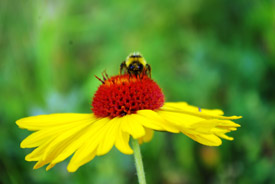13 tweetable facts about pollinators

Bee on flower (Photo by NCC)
Nature has always been a fascination of mine, sparking numerous moments of wonders and awe. Like the time when I first learned about how bee orchids are designed to entice certain pollinators leading to pseudocopulation - that blew my mind! As the season shifts towards warmer weather, more people are ditching the indoors for more time in nature. It’s also the perfect time to get acquainted with who’s visiting your gardens or pollinating the wildflowers in the green spaces surrounding your neighbourhood.
Share these fun facts and let everyone know just how amazing and important pollinators are!
Sources:
United States Department of Agriculture Forest Service
http://www.fs.fed.us/wildflowers/pollinators/gardening.shtml
A Guide to Toronto’s pollinators
http://www.davidsuzuki.org/issues/downloads/Pollinator_Guide_5pg.pdf
The Xeres Society for Invertebrate Conservation
http://www.xerces.org/wp-content/uploads/2010/11/pollinator-three-steps_fact_sheet2.pdf


